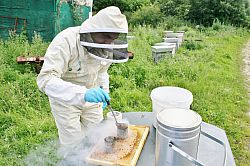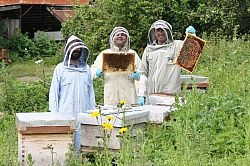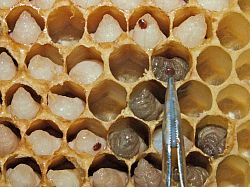It is not always an easy task to control the many pests and diseases of our honey bees. For many years beekeepers used fluvalinate to combat varroa mites. However, despite giving very good control, these mites are now resistant to this active ingredient in Apistan strips. In an attempt to help beekeepers and improve integrated varroa management, current research at the Laboratory of Apiculture and Social Insects (LASI) at the University of Sussex focuses on two main areas of pest and disease control.
The first of these is on hygienic behaviour which is a natural defence mechanism against brood diseases in which worker bees detect and uncap cells containing brood that is dead or infected. This behavioural trait allows diseases such as chalk brood, American foulbrood and Varroa to be fully or partly controlled. However, although hygienic behaviour in honey bees is natural, it is not common. Surveys of colonies, where patches of capped brood are freeze-killed with liquid nitrogen to quantify the rate at which the dead brood are uncapped and removed, generally show that only 10% of honey bee colonies are fully hygienic. This means that they remove 95% or more of the dead brood within 2 days.
 The freeze-killed brood technique using liquid nitrogen at an out-apiary
The freeze-killed brood technique using liquid nitrogen at an out-apiary
Hygienic behaviour is not learnt, but is an inherited trait. At LASI we have been able to breed a line of fully hygienic bees that remove 95% or more of the freeze-killed brood. Future funding permitting, we will be able to make this stock available to British beekeepers. During the past three years, LASI has run a number of workshops showing bee farmers and beekeepers how to carry out the freeze-killed brood assay. This enables beekeepers to screen and identify their own colonies with this desirable behaviour, and use them in their own queen rearing and breeding activities.
 LASI researchers testing colonies for hygienic behaviour
LASI researchers testing colonies for hygienic behaviour
Research at LASI has shown that hygienic colonies do not sting more or show reduced calmness during hive inspections, and that hygienic workers do not mistakenly remove healthy brood, meaning that hygienic behaviour is not costly to the colony. We have also shown that open mated queens reared from highly hygienic colonies give rise to highly hygienic colonies. To have highly hygienic colonies, it is not necessary to mate queens via instrumental insemination, making things much simpler for beekeepers and queen rearers. Our research, for example, shows that queen rearers in Britain could supply open-mated hygienic queens bred from locally-adapted bees.
How does hygienic behaviour aid disease control? An experiment in 2013 showed that the one-year build up of Varroa mites in fully hygienic colonies (>95% removal of freeze-killed brood) was less than half that of less hygienic colonies. Additionally, worker bees in these fully-hygienic colonies showed no symptoms of Deformed Wing Virus (DWV), which can be transmitted by Varroa. However, DWV was seen in a third of the non-hygienic colonies. These results show that hygienic behaviour can play an important role in controlling Varroa and the viral diseases it transmits.
The second area of LASI research on pests and diseases is on the direct control of Varroa mites. We have carefully quantified the effectiveness of two control methods. One of these is drone brood trapping which is frequently used by beekeepers. Varroa are particularly attracted to honey bee drone brood, the cells being larger and sealed for longer than workers cells. In one experiment our research shows that half a frame of drone comb placed into a hive in early spring, when the first batch of drones are being reared, can trap about half of the Varroa in the colony.
 Counting varroa mites in drone cells
Counting varroa mites in drone cells
The hygienic behaviour and varroa control research at LASI has been carried out by Norman Carrick, Dr Karin Alton, PhD students Gianluigi Bigio and Hasan Altoufalia, LASI’s research facilities manager, Luciano Scandian and several under-graduate summer helpers.
Publications:
Bigio, G., Al Toufailia, H., Hughes, W. O. H., Ratnieks, F. L. W. 2014. The effect of one generation of controlled mating on the expression of hygienic behaviour in honey bees. Journal of Apicultural Research 53: 563-568.
Bigio, G., Al Toufailia, H., Ratnieks, F. L. W. 2014. Honey bee hygienic behaviour does not incur a cost via removal of healthy brood. Journal of Evolutionary Biology 27: 226-230.
Bigio, G., Schürch, R., Ratnieks, F. L. W. 2013. Hygienic behavior in honey bees: effects of brood, food and time of the year. Journal of Economic Entomology 106: 2280-2285.
Bigio, G., Grüter, C., Ratnieks, F. L. W. 2012. Comparing alternative methods for holding virgin honey bee queens for one week in mailing cages before mating. PLoS One 7(11): e50150. doi:10.1371/journal.pone.0050150
Popular Journals:
Bee Craft article: Honey Bee Hygienic Behaviour.
For more info on Bee Craft see their website: http://www.bee-craft.com/
Hygienic Behaviour BBJ 1-18 [PDF 477.66KB]
And an article in the British Beekeeper's Association, British Bee Journal.


